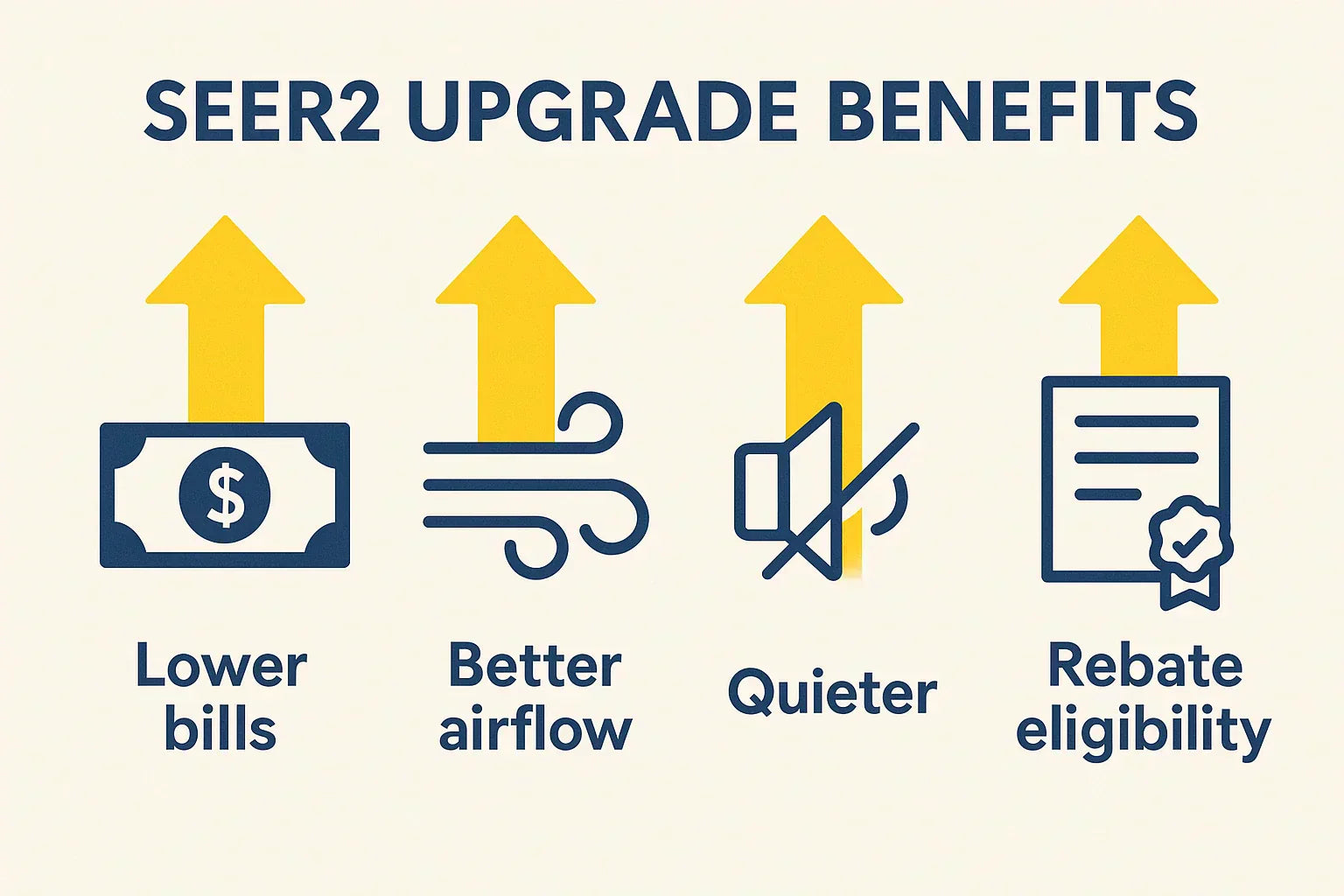If you're in the market for a new HVAC system, you've likely seen the term SEER2 popping up everywhere. As of 2023, SEER2 officially replaced SEER as the standard metric for rating cooling efficiency. But what does that mean for homeowners, and is it really worth upgrading to a SEER2-rated system?
Here’s the simple version: SEER2 is a smarter, more realistic way to measure HVAC efficiency. It was introduced by the Department of Energy (DOE) to better reflect real-world performance — especially when it comes to airflow resistance, also known as static pressure.
📘 SEER2.com – About the SEER2 Standard
The old SEER system tested equipment under near-perfect conditions, which rarely happen in actual homes. SEER2 raises the bar by simulating real-world ductwork resistance. So while a SEER2 rating may appear lower on paper than its SEER counterpart, it’s actually a more honest reflection of how your system will perform in your home.
How Much More Efficient Are SEER2 Systems?
Let’s clear up a common misconception: SEER2 ratings look lower, but the systems themselves aren’t less efficient. In fact, SEER2 units are more transparent about true efficiency.
Here’s how the two ratings compare:
| SEER | Approximate SEER2 Equivalent |
|---|---|
| 13 | 12.2–12.5 SEER2 |
| 14 | 13.4 SEER2 |
| 16 | 15.2 SEER2 |
| 18 | 17.0 SEER2 |
📘 Carrier – Understanding SEER2 vs. SEER
The takeaway? A 14 SEER unit from a few years ago may not meet code anymore. If you're upgrading your equipment, especially during a remodel or ductwork reconfiguration, going with a SEER2-compliant system is not just smart — it’s now required by law in many regions.
Real-World Benefits of Upgrading
SEER2 isn’t just a new label — it comes with tangible perks when you choose a high-efficiency unit:
✅ Lower Utility Bills
SEER2 units, especially those above 15.2, are optimized for better airflow and variable-speed performance. This leads to lower energy consumption, particularly during part-load conditions when systems run most often.
✅ Improved Comfort
Modern SEER2 systems often include variable-speed blowers and multi-stage compressors, which deliver more consistent temperatures and better humidity control — especially in humid or mixed-climate zones.
✅ Quieter Operation
More efficient airflow and variable speeds reduce noise. Many homeowners report a noticeable improvement in noise levels after upgrading.
✅ Access to Rebates and Tax Credits
Only SEER2 systems that meet or exceed certain thresholds qualify for federal incentives like the 25C tax credit and utility rebates.
📘 ENERGY STAR – Most Efficient HVAC Systems
When an Upgrade Makes the Most Sense
Upgrading to a SEER2 system can be a smart move — but especially in these situations:
🔧 Your current system is 10+ years old
Older units tend to be oversized, underperforming, and may use outdated refrigerants like R-22.
🧾 Your energy bills are climbing
Higher electric bills with no change in usage often point to declining HVAC efficiency.
🏡 You’re remodeling or replacing ductwork
SEER2-rated equipment is often a better match when you're redesigning duct systems for airflow balance.
💸 You’re eligible for rebates
Thanks to the Inflation Reduction Act and state-level programs, upgrading now can unlock hundreds or even thousands in rebates.
📘 Energy Star – 2025 HVAC Tax Credits & Rebates
Upgrade Costs vs. Long-Term Payback
The upfront cost of a SEER2 system can vary, but it typically ranges from:
-
$4,500 to $8,000 for standard 14.3–15.2 SEER2 units
-
$9,000 to $13,000+ for premium 17+ SEER2 systems with variable-speed capabilities
While that may sound steep, the long-term math often works out in your favor.
Sample Payback Period:
A 2,000 sq ft home replacing a 12 SEER unit with a 16 SEER2 system could save $300–$500 per year on cooling costs, depending on your climate and usage. That means a 5–8 year payback window, not including rebates.
📘 Trane – HVAC Payback Analysis
Final Thoughts: Is a SEER2 Upgrade Worth It?
If you’re already planning to replace your system, upgrading to a SEER2-rated unit isn’t just worth it — it’s likely required. But even if your current unit still “works,” here’s what to consider:
-
Do you want lower energy bills and more comfort?
-
Will you stay in the home long enough to see the payback?
-
Are you eligible for rebates or tax credits now?
-
Are you experiencing airflow issues or inconsistent cooling?
If you answered yes to even a couple of those questions, it’s worth talking to your HVAC contractor about a SEER2-rated upgrade.
📘 Want a deeper dive into why SEER2 matters and how it works? Start here:
🔗 What is SEER2 and Why It Matters
👉 Up next: How to Choose Between 14.3 SEER2 and 17 SEER2 Models
Alex Lane
Your Home Comfort Advocate







